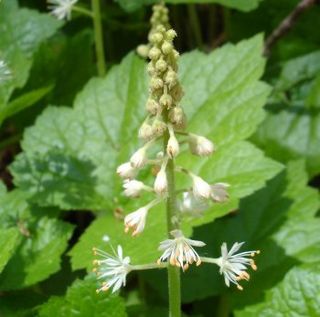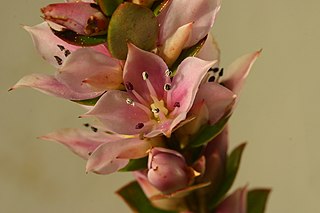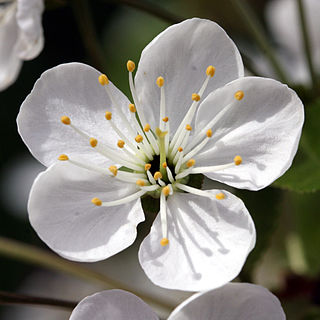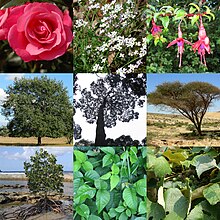
The Apiales are an order of flowering plants. The families are those recognized in the APG III system. This is typical of the newer classifications, though there is some slight variation and in particular, the Torriceliaceae may also be divided.

The Malpighiales comprise one of the largest orders of flowering plants, containing about 36 families and more than 16,000 species, about 7.8% of the eudicots. The order is very diverse, containing plants as different as the willow, violet, poinsettia, manchineel, rafflesia and coca plant, and are hard to recognize except with molecular phylogenetic evidence. It is not part of any of the classification systems based only on plant morphology. Molecular clock calculations estimate the origin of stem group Malpighiales at around 100 million years ago (Mya) and the origin of crown group Malpighiales at about 90 Mya.

Rosales is an order of flowering plants. It is sister to a clade consisting of Fagales and Cucurbitales. It contains about 7,700 species, distributed into about 260 genera. Rosales comprise nine families, the type family being the rose family, Rosaceae. The largest of these families are Rosaceae (90/2500) and Urticaceae (54/2600). The order Rosales is divided into three clades that have never been assigned a taxonomic rank. The basal clade consists of the family Rosaceae; another clade consists of four families, including Rhamnaceae; and the third clade consists of the four urticalean families.

Saxifragales is an order of angiosperms, or flowering plants, containing 15 botanical families and around 100 genera, with nearly 2,500 species. Of the 15 families, many are small, with eight of them being monotypic. The largest family is the Crassulaceae (stonecrops), a diverse group of mostly succulent plants, with about 35 genera. Saxifragales are found worldwide, primarily in temperate to subtropical zones, rarely being encountered growing wild in the tropics; however, many species are now cultivated throughout the world as knowledge of plant husbandry has improved. They can be found in a wide variety of environments, from deserts to fully aquatic habitats, with species adapted to alpine, forested or fully-aquatic habitats. Many are epiphytic or lithophytic, growing on exposed cliff faces, on trees or on rocks, and not requiring a highly organic or nutrient-dense substrate to thrive.

Under the International Code of Nomenclature for algae, fungi, and plants (ICN), Rosidae is a botanical name at the rank of subclass. Circumscription of the subclass will vary with the taxonomic system being used; the only requirement being that it includes the family Rosaceae.

The Celastrales are an order of flowering plants found throughout the tropics and subtropics, with only a few species extending far into the temperate regions. The 1200 to 1350 species are in about 100 genera. All but seven of these genera are in the large family Celastraceae. Until recently, the composition of the order and its division into families varied greatly from one author to another.

Saxifragaceae is a family of herbaceous perennial flowering plants, within the core eudicot order Saxifragales. The taxonomy of the family has been greatly revised and the scope much reduced in the era of molecular phylogenetic analysis. The family is divided into ten clades, with about 640 known species in about 35 accepted genera. About half of these consist of a single species, but about 400 of the species are in the type genus Saxifraga. The family is predominantly distributed in the northern hemisphere, but also in the Andes in South America.

The eudicots, Eudicotidae, or eudicotyledons are a clade of flowering plants (angiosperms) which are mainly characterized by having two seed leaves (cotyledons) upon germination. The term derives from dicotyledon. Previously, they were called tricolpates or non-magnoliid dicots by past authors. The current botanical terms were introduced in 1991, by evolutionary botanist James A. Doyle and paleobotanist Carol L. Hotton, to emphasize the later evolutionary divergence of tricolpate dicots from earlier, less specialized, dicots.
The APG II system of plant classification is the second, now obsolete, version of a modern, mostly molecular-based, system of plant taxonomy that was published in April 2003 by the Angiosperm Phylogeny Group. It was a revision of the first APG system, published in 1998, and was superseded in 2009 by a further revision, the APG III system.

Huerteales is the botanical name for an order of flowering plants. It is one of the 17 orders that make up the large eudicot group known as the rosids in the APG III system of plant classification. Within the rosids, it is one of the orders in Malvidae, a group formerly known as eurosids II and now known informally as the malvids. This is true whether Malvidae is circumscribed broadly to include eight orders as in APG III, or more narrowly to include only four orders. Huerteales consists of four small families, Petenaeaceae, Gerrardinaceae, Tapisciaceae, and Dipentodontaceae.

Haloragaceae is a eudicot flowering plant family in the order Saxifragales, based on the phylogenetic APG system. In the Cronquist system, it was included in the order Haloragales.
Aphloia is a genus of flowering plants that contains a single species, Aphloia theiformis, the sole species of the monogeneric family Aphloiaceae. It is a species of evergreen shrubs or small trees occurring in East Africa, Madagascar, the Mascarene Islands and the Seychelles.

Geissoloma is a genus of flowering plants in the monotypic family Geissolomataceae, native to the Cape Province of South Africa. Geissoloma marginatum is the only species in the family. It is sometimes called guyalone in English. The plants are xerophytic evergreen shrubs and are known to accumulate aluminum.
The APG III system of flowering plant classification is the third version of a modern, mostly molecular-based, system of plant taxonomy being developed by the Angiosperm Phylogeny Group (APG). Published in 2009, it was superseded in 2016 by a further revision, the APG IV system.

The superrosids are members of a large clade of flowering plants, containing more than 88,000 species, and thus more than a quarter of all angiosperms.

In phylogenetic nomenclature, the Pentapetalae are a large group of eudicots that were informally referred to as the "core eudicots" in some papers on angiosperm phylogenetics. They comprise an extremely large and diverse group accounting for about 65% of the species richness of the angiosperms, with wide variability in habit, morphology, chemistry, geographic distribution, and other attributes. Classical systematics, based solely on morphological information, was not able to recognize this group. In fact, the circumscription of the Pentapetalae as a clade is based on strong evidence obtained from DNA molecular analysis data.

Berberidopsis beckleri is a species of climbing plant found in cool rainforests in eastern Australia. Its common name is the montane tape vine. Ferdinand von Mueller described the plant as Streptothamnus beckleri from collections at the Clarence River.

The superasterids are members of a large clade of flowering plants, containing more than 122,000 species.
















